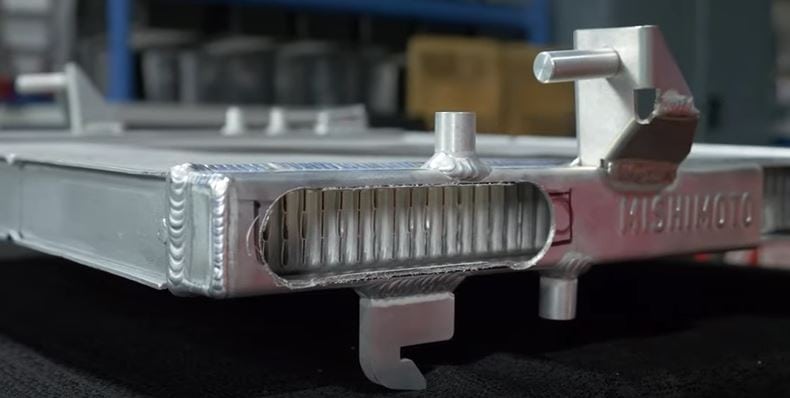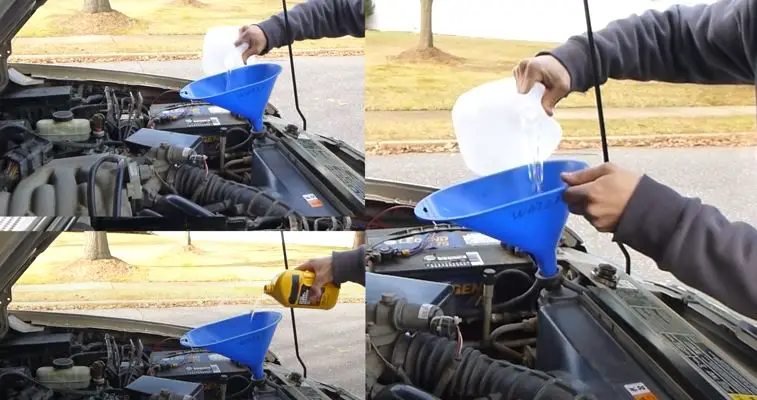How to Clean Rust Out of a Radiator?
A radiator is an important part of a gasoline engine, whether it is a car, motorcycle, ship, or generator. It spreads the engine’s heat in the air and prevents the engine from seizing. A special type of fluid called coolant circulates through small tubes throughout the engine and radiator. During this process, heated metal and evaporating coolant water react and forms rust which is our concern today.
Cleaning rust out of a radiator is a simple process. Flashing your vehicle’s engine with a rust-removing flusher several times, step by step, can clean the radiator and makes it lively.
It is a DIY job. So, even you can easily make your Car, Motorcycle, Generator, or Other Gasoline Engine’s Radiator free from rust. Let’s dive into the process.
Can You Clean a Rusty Radiator?

Of course, you clean a rusty radiator by yourself if you have the right tools like a spanner, wrench, and screwdriver set. It is an easy Do It Yourself job. Suppose you do not have the tools; you can’t do the job done. So, make sure you get them at the right time.
First, you have to examine the condition of your radiator. If the rusty coolant can still circulate, then do not worry. Just flush with the radiator flusher, and it becomes new.
But, before you start cleaning, you need to learn the basics of the Radiator, Rust, Radiator Flasher, Coolant/Antifreeze, and how it works for effective and perfect cleaning.
How Does Radiator Work?

When you start your vehicle’s engine, a water pump inside the engine kicks on and circulates the antifreeze liquid, also known as coolant. It circulates throughout the small tubes inside the engine and carries out the heat into the radiator with high pressure.
It has many microchannels to where the heated coolant goes inside with high pressure from one end. It goes out with low pressure from another end. During this course, coolant losses heat in contact with air and keep the engine at optimal temperature for running.
How Does Rust Form in a Radiator?
The radiator continues working the whole time of engine is running and playing with heat. During this process, heated metal and evaporated coolant reacts and form rust after using the same coolant. Sludge of coolant, a black mud-like substance of corrosion if it remains for a long time, builds oxidization in the radiator.
It blocks or narrows the small tubes of the engine and radiator’s microchannel. If the rust is too much, that will affect engine performance due to the overheating issue. And keep in mind that one of the main causes of engine seizing is the overheating issue of your vehicle.
How Does Radiator Flasher work?

The radiator flusher removes the molded grime, sludge, and rusted particles and takes them away with it. The active component of the radiator flasher is Tri-Sodium Citrate. When Tri-Sodium Citrate is mixed with coolant, Citrate change into Citric, and that is the key to moving away rust, sludge, and grime along with the coolant.
Other active components are Sodium-Formate and Sodium-Acetate. Though Radiator Flusher works fine, relieving your engine by cleaning rust, excessive use can damage your engine hardware. So, before using a flasher check the engine radiator specifications and what type of flush, how much, and what times can be used.
What is Coolant or Antifreeze?

Coolant or Antifreeze is a liquid used in the car radiator not only in gasoline engine vehicles but also in electric vehicles. This liquid is throughout the engine, absorbing heat and passing through the radiator. It losses heat in contact with the airflow when the car moves along.
In very cold weather, the coolant can freeze and cause blockages and damage to the engine. To avoid this phenomenon, an alcohol-based chemical is added to the coolant, lowering both its freezing and boiling points.
How to Clean a Rusty Radiator?

A rusty radiator does not cool an engine efficiently, the engine gets overheated too early, and your ride becomes feverish. So, it is important to check the condition of your radiator coolant condition in every six months.
Manufacturers recommend cleaning the radiator’s fin from the outside once every year. A complete flush and proper cleaning once every five years to improve the cooling system’s efficiency.
Flushing a rusted radiator is easy to learn. You can do it in your garage, but make sure your children and pets are away from the place and wear your old clothes because they can be messy.
However, the engine temperature is a crucial thing for your DIY job to be done safely, do it only when it is cold.
Which Parts Should You Clean in a Rusted Radiator?
To clean a rusted radiator, you must go through all the parts one by one associated with the vehicle’s cooling system. Rust can be accumulated in every corner of the room.
- Radiator
- Radiator Reservoir
- Radiator Fins
Materials Required in Cleaning the Rusted Radiator
For cleaning the rusted radiator, you need some materials that associate with the cleaning procedure. You can’t do the job without these products.
- Washing Shampoo
- Flasher
Three types of flashers are available in the market. Don’t hesitate; any type of flasher works perfectly fine. Just grab the available one.
1. Liquid Flasher
2. Powder Solutions
3. Pressure-Based
- Distilled Water
- Coolant or Antifreeze
Step by Step Process of Radiator Flushing and Cleaning
Radiator flushing and cleaning are different in their purpose. Flushing is done to clean the inside of the radiator, and Cleaning is done to clean the outside of it. So, we separate the flushing and cleaning process for your convenience.
Radiator Flushing

Now, we will discuss the step-by-step process of flushing the rusty radiator.
Step 1: Pre-Flush

When you decide to super flush the radiator, at first, you should pre flushing before the super flush. It means an adequate pore of rust cleaning flusher on the radiator reservoir and drives 100 miles more. In the meantime, with this solution, you pre-flush, loosen up all the gunk, sludge, and rust, and get ready for the big blast.
Step 2: Draining the Coolant from the System

When you ride your vehicle more than 100 miles with the pre-flush, now is time to drain the complete coolant from your car. Park your vehicle in your garage or a safe place, and make sure to engage the emergency brake. Run the car idle for 5 min with turn on the air conditioner or heater, then turn it off.
Place a pot or bucket under the radiator, open the radiator reservoir lid and unscrew the Pet-coke (radiator drain bolt). Make sure not to spell any coolant besides the coolant pot. It is hazardous to the environment. When the coolant drain is complete, then tight the Pet-coke.
Step 3: Fill up with the Flusher

To super flush the radiator, fill up the radiator and the reservoir with the flusher and distilled water according to the Flush requirement.
Step 4: Super Flushing
Start your car and turn on your cooler or heater on high for the respective time given by the flusher manual.
Step 5: Drain the Flush
After completing the super flush with the heater or cooler on, wait until the engine becomes cool and then drain the flusher following step-2 again.
Step 6: Distilled Water Cleaning

After draining the flush, you need to clean the full system again with distilled water to remove the flusher completely. Fill up the radiator again with distilled water and run the vehicle for 15-20 minutes with the cooler or heater turned on high. After that, cool the engine and drain the water completely.
Step 7: Fill up the Radiator with Coolant or Antifreeze

Follow your vehicle’s owner’s manual for the right coolant at the right amount. For example, some car manuals suggest green coolant and some red coolant at a 50/50 coolant and distilled water ratio. So, check yours, fill up the radiator and reservoir up to the maximum level, and close all the plugs and lids.
Step 8: Test Run

Finally, you completed your radiator super flushing. Now, run the system to check for any leakage and complication. Running after one week, check the reservoir for coolant concentration, and if it needs to adjust, then adjust.
Radiator Cleaning

In the time of the flushing process, you can clean your radiator’s outside part.
Cleaning Radiator Fins

Cleaning the radiator outsides fin is also important as inside flushing. It improves the efficiency of the radiator. To clean the fins, you should use washing shampoo, spray it on the fins, and wait to dissolve the dust and mud completely. Then wash it with medium water spray and dry it.
Cleaning Radiator Reservoir

Wash your radiator reservoir with medium water spray when you drain the coolant, flusher, and distilled water. So, by washing respectively three times, your coolant reservoir becomes completely clean.
Can I Use Vinegar to Flush My Radiator?
No, you cannot use vinegar to flush your radiator. Though it works as a cleaning agent, vinegar’s acetic acid makes metal such as steel and aluminum corrosive and allows them to rust. So, it is good for your vehicle’s longevity not to use vinegar as a radiator flusher.
Use appropriate Radiator Flusher only for your vehicle’s better performance and long life.
Frequently Asked Questions
Why do radiators go rusty at the bottom?
There are a few reasons why radiators can rust at the bottom. One reason might be that the radiator is not draining properly, which can cause water to stagnate and create rust. Another possibility is that something is blocking the drainage system, such as a leaf or other debris. Finally, if the radiator is old or has been exposed to moisture, it is more likely to rust.
Can you paint over rusty radiator?
Yes, you can paint over a rusty radiator. But you must clean the rust off first. Use a wire brush to scrub away the rust. Then put primer on it so the paint will stick. After the primer is dry, you can paint it with your desired color.
What happens if intake manifold is dirty?
Dirty intake manifold can lead to problems with the engine. The engine may fail to get enough air, which can lead to malfunctions. Additionally, the dirt causes the engine to overheat. Cleaning lower intake manifold may seem like a daunting task, but it’s really not that difficult. With the right tools and a little elbow grease, you can have your lower intake manifold looking like new in no time.
– Can the Same Cleaning Method for Varnish be Used to Clean Rust Out of a Radiator?
When trying to clean rust out of a radiator, the same cleaning method used for varnish may not be effective. Using a specific cleaning solution designed for rust removal in radiators is crucial. The “clean varnish gas tank” method won’t suffice. It’s important to use the right cleaning products for each specific cleaning need.
Conclusion
You should now understand the importance of a clean radiator for your vehicle. If you want to span the longevity, efficiency, mileage, and smoothness, always try to keep the cooling system clean. And on that note, you should teach yourself how to clean cooling stack on Duramax for your vehicle.
If it is not done regularly, rusts, sludges, and other dust particles can block the passage over time can, cause overheating issue, and damages your engine very badly. By cleaning properly, it can easily transfer the heat and keep the performance of your vehicle up to the mark.
So, do a check-up of your vehicle’s radiator once every six months and remain hassle-free.

